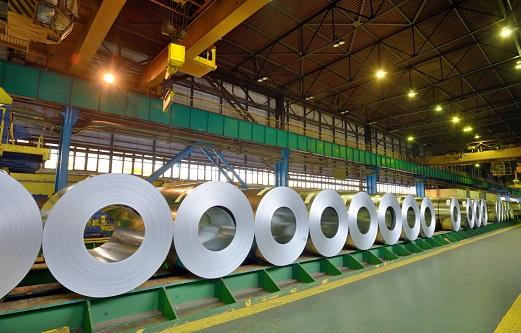President/CEO
- FMA
- The Fabricator
- FABTECH
- Canadian Metalworking
Categories
- Additive Manufacturing
- Aluminum Welding
- Arc Welding
- Assembly and Joining
- Automation and Robotics
- Bending and Forming
- Consumables
- Cutting and Weld Prep
- Electric Vehicles
- En Español
- Finishing
- Hydroforming
- Laser Cutting
- Laser Welding
- Machining
- Manufacturing Software
- Materials Handling
- Metals/Materials
- Oxyfuel Cutting
- Plasma Cutting
- Power Tools
- Punching and Other Holemaking
- Roll Forming
- Safety
- Sawing
- Shearing
- Shop Management
- Testing and Measuring
- Tube and Pipe Fabrication
- Tube and Pipe Production
- Waterjet Cutting
Industry Directory
Webcasts
Podcasts
FAB 40
Advertise
Subscribe
Account Login
Search
Flat-rolled Steel Inventory Index to provide clearer picture of demand
Goal of new research: Focus on “days” of inventory on hand
- By John Packard
- September 20, 2017
Steel Market Update (SMU) is working on a new index to measure flat-rolled steel inventories in service center warehouses at the end of each month. The information will allow service centers to compare their inventory levels to those of their peers and help them determine when and how much to replenish.
Service center inventory levels are a barometer of demand. When demand is on the rise, inventories tend to tighten and prices tend to increase. When demand is slow, inventories grow and prices soften. Demand, in turn, affects lead times. In periods of high demand, it takes service centers longer to get material from the mills. Likewise, in some cases, service center customers may find they must wait longer for deliveries. As a result, the trends revealed by SMU’s new index not only will prove useful to service centers, but also to the fabricators and OEMs that buy flat-rolled steel from them.
SMU is currently developing a list of service centers across the country that will regularly supply inventory information at the end of each month. We are working to recruit a good cross section of the marketplace, companies both large and small. Their identities will remain strictly confidential. We will use the collected data to come up with a flat-rolled inventory average for the group. We also will communicate directly with distributors to collect comments on why inventory levels change from one month to the next.
Initially we have been asking contributors to estimate “months of supply,” which is somewhat subjective. As we build up the number of information providers, we will switch to “days of inventory on hand,” which we believe will be more accurate.
Over time our goal is to ask service centers to break out individual products—hot-rolled, cold-rolled, galvanized, and Galvalume steels—so that we can focus on specific product trends. We also plan to expand our coverage to include plate, for which we will develop a second group of distributor sources independent of our flat-rolled group.
SMU’s inventory index will be delivered first, at no cost, to those service centers that provide information. Shortly after, a monthly analysis of the inventory data will be made available to SMU subscribers. Nonsubscribers will have the option to purchase the index separately.
What Does the Current Inventory Situation Tell Us?
At the end of July, flat-rolled steel service center inventories averaged 2.77 months of supply, based on responses received from the service centers reporting to us at that time. Inventories ranged from a low of 1.8 months to a high of 4 months. At the end of August, with 16 additional information providers, service center flat-rolled inventories remained stable at an average of 2.72 months of supply.
These numbers suggest that demand and lead times are relatively stable (see Figure 1). In fact, data from the Sept. 11 regular flat-rolled steel market trends questionnaire supports that hypothesis (see Figure 2). None of the service centers responding indicated they were building inventories. The clear majority, about 77 percent, called their inventories “balanced,” while the remaining 23 percent told SMU their inventories were too high and needed to be reduced.
What does this tell steel buyers about demand and pricing? Major mills have announced price hikes of around $30/ton in the past month. With average inventories below three months and service centers planning to maintain or even reduce inventory levels, the mills may have a hard time collecting those higher steel spot prices under current market conditions.

Figure 2. Steel service centers are not feeling the need to replenish inventories in any great way. That means a pretty stable market for steel users.
How to Become a Data Provider
SMU continues to look for qualified flat-rolled distributors in both the U.S. and Canada who are willing to share (confidentially) inventory data on hot-rolled, cold-rolled, galvanized, and Galvalume steels. The initial inquiry will be based on months of supply of all flat-rolled on the floor at the end of each month. Eventually we will break out the various products. Ultimately we will be looking for shipment information and total inventories so we can move from months of supply to days of supply, which we believe is more useful to buyers and sellers. SMU also wants to provide plate data to subscribers. Therefore, we need plate distributors who are willing to provide similar inventory information.
If your company has any questions or is interested in becoming a data provider, please contact John Packard at john@steelmarketupdate.com or call 800-432-3475.
John Packard and metallurgist John Eckstein will be providing a “mini” version of the Steel 101: Introduction to Steel Making and Market Fundamentals workshop at FABTECH in Chicago. Their program will be held on Tuesday, Nov. 7 from 1:30-3:30 p.m. in Room 502 B. The educational presentation is part of the Forming & Fabricating track of the FABTECH Education Program. The official title of the program is Steel 101: Mill to Fabricator.
subscribe now

The Fabricator is North America's leading magazine for the metal forming and fabricating industry. The magazine delivers the news, technical articles, and case histories that enable fabricators to do their jobs more efficiently. The Fabricator has served the industry since 1970.
start your free subscriptionAbout the Author

John Packard
800-432-3475
John Packard is the founder and publisher of Steel Market Update, a steel industry newsletter and website dedicated to the flat-rolled steel industry in North America. He spent the first 31 years of his career selling flat-rolled steel products to the manufacturing and distribution communities.
- Stay connected from anywhere

Easily access valuable industry resources now with full access to the digital edition of The Fabricator.

Easily access valuable industry resources now with full access to the digital edition of The Welder.

Easily access valuable industry resources now with full access to the digital edition of The Tube and Pipe Journal.
- Podcasting
- Podcast:
- The Fabricator Podcast
- Published:
- 04/16/2024
- Running Time:
- 63:29
In this episode of The Fabricator Podcast, Caleb Chamberlain, co-founder and CEO of OSH Cut, discusses his company’s...
- Trending Articles
Tips for creating sheet metal tubes with perforations

JM Steel triples capacity for solar energy projects at Pennsylvania facility

Are two heads better than one in fiber laser cutting?

Supporting the metal fabricating industry through FMA

Omco Solar opens second Alabama manufacturing facility

- Industry Events
16th Annual Safety Conference
- April 30 - May 1, 2024
- Elgin,
Pipe and Tube Conference
- May 21 - 22, 2024
- Omaha, NE
World-Class Roll Forming Workshop
- June 5 - 6, 2024
- Louisville, KY
Advanced Laser Application Workshop
- June 25 - 27, 2024
- Novi, MI



























